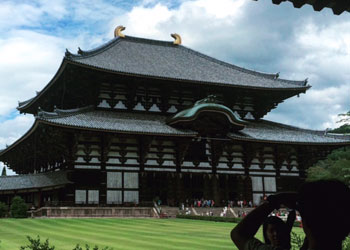

 Raphael Barnes
Raphael Barnes
The Hudson School
Hoboken, NJ
I open my eyes. I am lying on the airplane floor, completely disoriented. A fellow Mipper -- what we call our fellow JET-MIP participants -- is kneeling by my side, four words escape her mouth: “You had a seizure.” Finding it hard to believe, and assuming that I knew myself well enough to never have one, I immediately rejected the possibility of it even occurring. But it was true. Approximately three hours into that plane ride, I had a seizure for a few minutes, and then passed out for about a half hour. Following this incident, I felt completely fine, though most were very concerned, naturally. Japanese airplane stewardesses would often come up to me with the genuinely concerned, “Are you okay?” This was understandable, for I did just faint on a plane.
I was momentarily disappointed, to say the least. For following my incident, I did not have the opportunity to travel to Rikuzentakata, one of the most devastated areas in Japan as a result of the 2011 Earthquake and Tsunami. Additionally, this was a particularly important part of the trip because my final project concerned the High School Summit that is held there annually. Out of concern for my health, well being, and safety following my seizure, members of the Japan Foundation thought it would be best that I stay back for two days while the other thirty-one participants go off to the Tohoku region. They had arranged for me to take language classes with Mexican students who had also been there on one day, and then spend the other on my own, doing whatever I would like to do.
My first day alone went by quickly. I had gotten along well with the other students. I had ridden a bike around the area and visited the mall. But the second day seemed endless. I did the same things that I had done the previous day: visited the mall, rode a bike -- further this time, reaching the harbor so that I was able to look out at the sea. But at night, I felt lonely, troubled. I walked around the building complex; all was quiet and most rooms completely dark. It had seemed as if nobody was around -- the Mexican students had gone to Kyoto for the whole day, and I was not sure where the receptionists at the front desk were. My footsteps echoed as I walked through dark corridors, and it gave me a chilling feeling. It was haunting being alone in that building, and I felt as if this signified one thing: it was time for me to leave.
The next morning, I left for the Tohoku region, glad that I could be reunited with the others. The process of getting there was long: riding a train to the Kansai International Airport, then sitting on an airplane for an hour, followed by another train to the station in Sendai. There, I was able to get to know my fellow participants better, as well as explore more of Japan. But as I walked through the mall, I felt both intrigued, and very foreign. I was obviously aware of the fact that I was an American in a different country, but it was made clear to me by the many stares from Japanese people passing by. Nevertheless, I felt as if my time spent there were some of the best days during my experience in Japan.
After spending four days in Sendai, consisting mostly of visiting various schools, establishing friendships with Japanese students both young and old, learning about disaster relief, and walking around the mall and the surrounding downtown area, we headed back to the Kansai Institute in Osaka. At this point, I had gotten to know my fellow participants very well, so I was looking forward to the remainder of the trip.
Living with my host brother Shintaro and his family was an important part of my trip to Japan because it enabled me to experience Japanese home life. Shintaro was a fifteen-year old boy who was initially shy but eventually warmed up to me, as he told me about his interests and hobbies -- mainly soccer. Though it was only for one night and one day, I felt as if my Japanese homestay was so much more than just a homestay. Upon arriving at their house in Izumi, Osaka, my host mother, Toyoko, began to ask me questions regarding my interests so that she could arrange something for Shintaro and me to do during the afternoon. That day, I visited the Osaka Prefectural Museum of Yayoi Culture, and a secluded Shinto shrine, which I was mesmerized by due to its large scale in such a hidden place. The next day, my host family took me to the Todaiji Temple in Nara, and the deer park. I was content with my overall experience with my host family because they were able to make it an enjoyable experience that I will never forget.
It is often said that the most important step in learning a language is visiting the country itself. As a student who has been studying Japanese for four years, I am glad that I had the opportunity to visit and experience things first hand, despite limitations. The JET-Memorial Invitation Program was established in memory of Taylor Anderson and Montgomery Dickson, two JET participants who tragically lost their lives in the midst of the 2011 Earthquake and Tsunami in Japan. If I could have ever met both of them, I would thank them for inspiring both American and Japanese youth to continue making an effort to engage in cultural exchange.

“Todaiji, Nara (奈良の東大寺)”
I chose this image as a reminder of my one-day homestay in Japan. Upon arriving here, I'd planned on visiting many sites, and I was fortunate that my host family offered to take me to this extraordinary place.